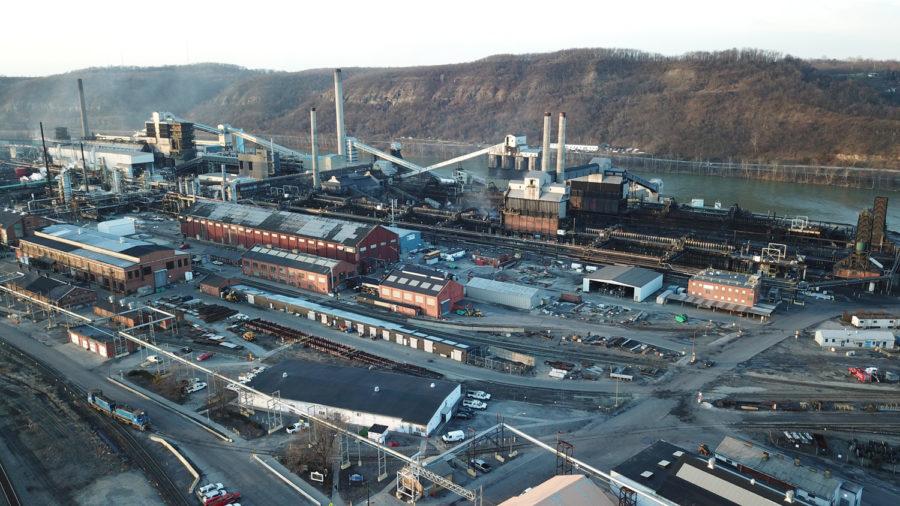Pittsburgh receives “F” for air quality despite decades of improvement
U.S. Steel’s Clairton Coke Works plant.
May 14, 2019
Pittsburgh has made strides in distancing itself from its industrial past, but the region remains plagued by lingering air quality concerns.
Allegheny County received an “F” rating from the American Lung Association in this year’s “State of the Air” report in every category due to particulate matter, or PM, and ozone concentrations that exceeded national air quality standards. Out of 203 metropolitan areas, the Pittsburgh tri-state area — which encompasses parts of Ohio and West Virginia — ranked seventh in worst annual PM pollution.
Between 2015 and 2017, the years considered in the 2019 report, Allegheny County had an average of 8.3 days each year that exceeded the ozone standard and 10.5 days that exceeded the PM standard — more than 3.2 days above either standard is considered a failing grade. In addition, the average annual PM concentration was 13.0 micrograms per meter cubed — anything above the air standard of 12.0 micrograms per meter cubed is considered failing.
According to the Environmental Protection Agency, intake of PM, which is usually made up of dust and soot, is associated with heart problems, difficulties breathing and aggravated asthma, while ozone primarily has an effect on breathing and can lead to chronic impaired lung function.
These are two primary pollutants considered when evaluating air quality. But while the region did receive a failing grade for the past several years for these pollutants, it has shown marked improvement within the past few decades. Between 2000 and 2002, the Pittsburgh metro area had on average 47.5 days annually which exceeded the ozone standard. During that two year period, the area also exceeded particulate limits 62 times annually and had an average PM concentration of 21.4 micrograms per meter cubed.
Other parts of the country fared worse this year than Pittsburgh in the rankings. Regions of California, particularly in southern California and the Central Valley, received failing grades in both PM and ozone as well — these areas are more prone to chronic bad air quality due to local climate and wildfires.
But though the Pittsburgh region has made progress, the current air quality still poses a health risk to everyone, according to Matthew Mehalik, the director of the Breathe Project, a Pittsburgh organization focused on air quality issues. Mehalik said chronic exposure to the poor air quality in Pittsburgh can lead to serious health issues.
“It affects everyone,” Mehalik said. “Being exposed to bad air quality every day of the year … that leads to very negative long-term health outcomes. It partially explains why we are rated as a county in the top 2% of counties nationwide for cancer risk from point source air pollution.”
Anaïs Peterson, executive vice president of next year’s Student Government Board and former columnist for The Pitt News, said in a phone interview she’s concerned about the detrimental impacts of poor air quality on public health.
“What happens in Allegheny County, what happens in southwest Pennsylvania affects everyone because pollution doesn’t stay in one place,” Peterson said. “We can’t afford for elected officials to be silent until after it’s done.”
Peterson said she plans to petition for the University to get an on-campus air quality monitor, which would send alerts to students in cases of unhealthy air quality.
The Allegheny County Health Department recently levied large fines against U.S. Steel for consistent violations of air quality standards. The ACHD levied a $337,670 fine against the company Monday for continued air quality violations during the first quarter of 2019. This comes after more than $2.3 million in fines between June 2018 and April 2019.
Karen Hacker, the director of the ACHD, said in a statement the county is working hard to improve air quality in the region, especially in light of the recent ALA report.
“The latest report is another reminder that air quality continues to be one of the most pressing public health challenges in our area,” Hacker said. “While we have ramped up our enforcement efforts over the past two years, doing more than our agency has ever done, we must continue to be aggressive and proactive and hold polluters accountable.”
But while the ACHD continues to regulate air quality in the region, it is limited in the scope of its power. Hacker spoke on March 26 at a Brilliant Breakfast, a weekly event hosted by the University Honors College. During the event, Hacker said her organization is unable to make immediate changes to air quality despite the organization’s best efforts.
“You’re ruled by a whole variety of rules and regulations, federal, state. And industry has rights — there’s this thing called due process,” Hacker said at the event. “You can levy an enforcement action and the industry can appeal. And they can drag it on and on for pretty much ever.”
Mehalik agrees that the ACHD is doing more than it has in the past to regulate air quality.
“We like seeing strong regulatory action,” Mehalik said. “We have seen a shift in the county’s willingness to be aggressive to at least impose fines on industries that are technically operating outside of the law by emitting pollution outside of what their permits allow them to emit.”
But while he agrees plenty is being done, he said progress still needs to be made in order to have healthy air for everyone in the Pittsburgh area.
“We’ve got a long way to go in order to have health-protective outcomes for our region,” Mehalik said. “We’re happy the health department is doing more. There needs to be continuing accountability on the part of polluting industry.”
This story has been updated to better reflect Mehalik’s view of the ACHD.



